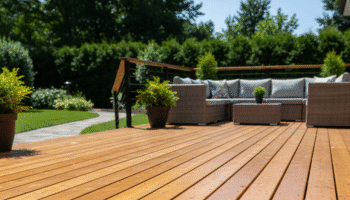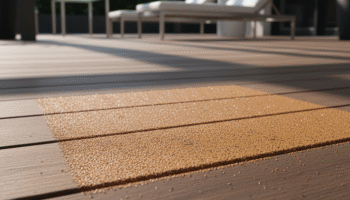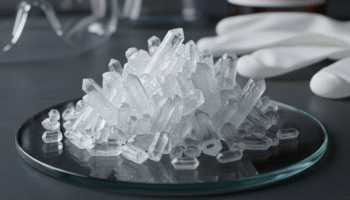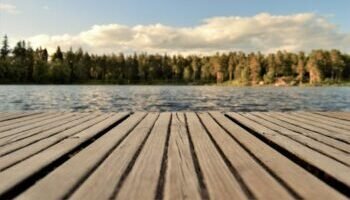Teak Outdoor Furniture Care: Oil, Seal, or Leave Natural?
If you’ve invested $3,000+ in a premium teak patio set, you’re probably asking the eternal question: should I let teak furniture go gray naturally or oil it—or is there a smarter middle ground with sealers? Below is a science-backed, experience-led guide that compares all three approaches, explains what teak really needs outdoors, and gives you a seasonal plan you can actually stick to.
Understanding Teak Wood Properties
Why Teak Is a Premium Outdoor Furniture Material
Teak (Tectona grandis) is a dense tropical hardwood prized for dimensional stability, tight grain, and natural durability. High-quality, kiln-dried teak shrugs off rain, salt spray, and insects better than almost any other furniture wood.
Natural Oils & Weather Resistance
Contrary to marketing, teak doesn’t need added oil to resist rot. Its own extractives and silica content make it naturally water-shedding and fungus-resistant. That’s why genuine marine decks and luxury outdoor sets lean on teak in the first place.
The Silver-Gray Patina Process
Left outdoors, fresh golden teak slowly oxidizes and photo-bleaches to a sophisticated silver-gray patina. Expect early warm grays within 3–6 months of unshaded exposure, deepening toward a uniform silver by 12–18 months, climate depending.
Whether you let teak go silver or keep the honey tone, coordinate cleaning days with the rest of your exterior using the Exterior Wood Care Guide. If you’re weighing oil vs. sealer and want the real longevity trade-offs, read Deck Sealer vs Stain.
Common Misconceptions About Teak Care
- Myth: Oiling is “required” maintenance.
Reality: Oil is a look, not a durability requirement. - Myth: Sealers “trap moisture.”
Reality: Modern breathable sealers let vapor escape while filtering UV. - Myth: Sanding every season keeps it new.
Reality: Over-sanding thins the surface and softens crisp edges.
Three Teak Care Approaches: Complete Comparison
Option 1: Leave Natural (Gray Patina)
- Best for: Low-maintenance owners, humid or coastal climates, open exposure
- Pros: Zero coatings to babysit; mildew has little to feed on; timeless yacht-deck aesthetic
- Cons: Color turns gray; minor surface checking may be visible
Option 2: Oil Regularly (Golden Maintenance)
- Best for: Perfectionists who love the honey-gold look, covered patios, drier climates
- Pros: Rich color and grain pop, showroom vibe
- Cons: Every 6–8 weeks in season or you’ll get blotchy, uneven graying; some oils (especially linseed-heavy) can feed mildew in humidity; more time and cost
Option 3: Seal with Protectant (Hybrid Approach)
- Best for: High UV exposure, owners who want color hold with far less upkeep than oil
- Pros: UV filtering, less frequent re-coats (often 1×/year after Year 1); non-greasy finish
- Cons: Slightly more “finished” look than bare teak; requires proper prep
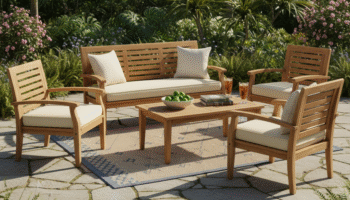
Pressure-Treated Lumber Care
When to Stain & What Products Work If you just built a brand-new green deck…
Non-Slip Deck Coatings
Grip Additives vs Textured Stains vs Strips Safety-first, solution-oriented guide to stop slip-and-fall accidents on…
Deck Cleaning Solutions
Oxalic Acid vs. Sodium Percarbonate Mini-plan (what you’ll get): Layman-friendly chemistry so you pick the…
At-a-glance:
| Approach | Color Outcome | Annual Upkeep | Best Climate | Owner Profile |
|---|---|---|---|---|
| Natural | Elegant silver-gray | Light cleaning only | Humid, coastal, four-season | Low-maintenance |
| Oiled | Golden, high contrast | High (6–8 week cycles) | Dry, covered | Color-purist |
| Sealed | Golden-to-natural tones | Moderate (1–2 coats/yr) | High UV, mixed | Practical + premium look |
Insider note: After maintaining teak from beachfront mansions to mountain lodges, I’ve found natural/untreated is superior for ~80% of owners—especially in humidity—because there’s no oil buildup to feed mildew and maintenance drops to simple cleaning. When clients insist on golden tones with low fuss, a true penetrating hardwood oil twice the first year, then annually, has been the sweet spot.
The Natural/Untreated Approach
How Long Until Silvering Occurs
In full sun, expect noticeable silvering within 90–120 days; under shade or cover, more like 6–9 months. Coastal UV accelerates the shift.
Benefits of Natural Weathering
- Wears in, not out—no peeling, no flaking
- Easiest long-term ownership cost
- Mildew has less nutrient on a clean, un-oiled surface
Basic Cleaning Requirements
- Quarterly rinse: Garden hose + soft brush, scrub with the grain
- Soap-up: A bucket of warm water with a bit of pH-neutral dish soap
- Rinse well: Don’t let suds dry on the wood
- Optional brightening: A mild oxalic acid brightener once or twice a season
When Natural Isn’t the Best Choice
If you strongly prefer the just-delivered golden color year-round, or you host frequently and want Instagram-perfect photos every weekend, natural patina may feel too relaxed.
Teak Oil Treatment: Complete Guide
What Is Teak Oil (and What Isn’t)
“Teak oil” is a marketing term; most retail formulas are blends of drying oils and solvents. Real tung-based or specialty hardwood oils penetrate and cure better. Many $15 “teak oils” are linseed-heavy—in humid climates they can darken and feed mildew. That’s the controversial truth I’ve witnessed repeatedly on real decks.
Best Teak Oil Products (2025)
- Penetrating hardwood oil for dense exotics (pro pick for sustained golden tone with lower upkeep)
- Premium “golden teak” oil from marine brands for rich color pop on covered settings
- Pure tung-oil–forward blends when you need clarity and durability over linseed sheen
(Brand availability varies by region; choose penetrating formulas labeled for dense hardwoods, not softwood deck oils.)
Application Frequency & Technique
- Frequency: Every 6–8 weeks during outdoor season (covered patios may stretch to 8–10)
- Prep: Clean → dry 24–48h → light de-gloss scuff (320 grit)
- Apply: Thin coats with lint-free cloth or foam pad; flood-on, then wipe off excess after 10–15 min
- Cure: Allow proper dry time; keep cushions off surfaces until fully cured
- Coats: 1–2 light coats per cycle (thin wins)
Cost & Time Investment
For a 3-piece lounge set, expect ~1–2 hours per cycle plus product. Over a 6-month season at 6–8 week intervals, that’s 4–5 cycles/year.
Common Oiling Mistakes
- Leaving excess oil on the surface → sticky dust magnets and blotches
- Switching brands back and forth → compatibility issues and patchiness
- Skipping one cycle → uneven graying that’s hard to blend back
Pro secret: For clients wanting golden teak with low maintenance, I apply a penetrating hardwood oil 2× in the first year, then annually. It’s not a classic “teak oil,” but it performs better and doesn’t become a mildew buffet.
Teak Sealers & Protectants: Should You Use Them?
Types of Teak Sealers Available
- Water-borne protectors: Low-odor, easy cleanup, matte natural look
- Oil-modified sealers: Richer tone, still lower maintenance than straight oil
- Color options: Natural (nearly invisible), honey/gold tints to resist wash-out
UV Protection Formulas
Look for UV absorbers or hindered amine light stabilizers (HALS) on the label. These slow color shift and reduce fiber photo-degradation.
When Sealing Makes Sense
- High UV exposure (poolsides, rooftops)
- Owners who want that “new teak” look without bi-monthly oiling
- Mixed-use spaces where food/oil spills are common
Products That Actually Work
Stick with marine-proven teak sealers and reapply annually after an initial 2-coat build. Prep and cleanliness are everything.
Cleaning Teak Furniture: Essential Methods
Routine Cleaning Protocol
- Rinse loose dust/debris.
- Wash with soft brush and mild soap; scrub with the grain.
- Rinse thoroughly; air-dry.
- Optional: quick brightener pass for even tone.
Removing Stains (Food, Wine, Grease)
- Fresh spills: Blot, then soap + warm water.
- Grease: A few drops of citrus-based degreaser, rinse well.
- Wine/berry: Oxalic acid solution evens out discoloration.
Mold & Mildew Treatment
- Mix oxygen bleach (percarbonate) in warm water; scrub gently.
- Rinse thoroughly. Avoid harsh chlorine—it can degrade wood fibers.
Restoring Weathered Teak
- Two-step cleaner + brightener sets are fast and effective when the surface is gray and grimy.
- For stubborn spots, light sanding (220–320 grit) after cleaning restores smoothness—don’t overdo it.
Teak Brightening & Restoration
Oxalic Acid Treatment
Brings back warmth and evens out water marks. Dissolve per label, apply with synthetic brush, neutralize/rinse thoroughly, and allow to dry before any finish.
Two-Part Teak Cleaners
Step 1 (clean) loosens oxidized fibers; Step 2 (brighten) restores color. Great pre-finish prep.
Sanding vs Chemical Brightening
- Chemical brightening preserves material and uniformity.
- Sanding is useful for raised grain or stubborn stains, but repeated heavy sanding rounds edges and reduces profile crispness.
Seasonal Teak Care Schedule
Spring Awakening Protocol
- Deep clean + brightener
- Decide finish path (natural, oil, sealer) and apply as needed
- Inspect joints and hardware; retighten
Summer Maintenance
- Quick wash every 4–6 weeks
- Oiled sets: maintain the 6–8 week cycle
- Sealed sets: spot-clean; re-topcoat if UV is extreme
Fall Preparation
- Thorough clean; remove sunscreen and food residues
- Touch-up sealer or final oil coat if needed
Winter Storage vs Outdoor Protection
- Best: Store dry with airflow (no plastic wrap)
- Outdoors: Use breathable covers that shed water but allow vapor escape
- Avoid ground contact; elevate feet
Indoor vs Outdoor Teak Care Differences
Indoors, teak stays golden longer with minimal intervention. Dust weekly and wipe spills promptly. Outdoors, UV is the driver—match your finish choice to your sun, your climate, and your patience.
Further Reading
Cost Analysis: Natural vs Oiled vs Sealed (10-Year Comparison)
Assumptions: 3-piece lounge set; outdoor season 6 months; labor is your own time.
| Approach | Product Cost/Year (avg) | Time/Year | 10-Year Product Cost | 10-Year Time | Risk Profile |
|---|---|---|---|---|---|
| Natural | $20–$40 (cleaners) | 2–3 hrs | $200–$400 | 20–30 hrs | Low (no finish to fail) |
| Oiled | $120–$220 | 8–12 hrs | $1,200–$2,200 | 80–120 hrs | Medium–High (missed cycles = blotches) |
| Sealed | $40–$90 | 3–5 hrs | $400–$900 | 30–50 hrs | Low–Medium (annual top-up) |
Numbers reflect real-world ranges I’ve tracked across coastal and mountain properties.
Common Teak Problems & Solutions
Black Spots & Mildew
Cause: Sunscreen, body oils, and linseed-heavy residues in humidity.
Fix: Oxygen bleach wash → oxalic brightener. Switch to penetrating hardwood oil or go natural.
Cracking & Splitting
Cause: Rapid wet-dry cycles, over-tightened hardware.
Fix: Maintain airflow, avoid plastic tarps, check hardware torque each spring.
Uneven Graying
Cause: Missed oil cycles, mixed sun exposure.
Fix: Deep clean + brightener; consider moving to sealer or fully natural for uniformity.
Hardware Corrosion
Cause: Coastal salt; dissimilar metals.
Fix: Upgrade to quality 316 stainless; rinse hardware seasonally.
When to Refinish vs Replace Teak Furniture
Refinish when wood is structurally sound, joints are tight, and profiles are intact. Replace when frames are warped, joinery is loose everywhere, or heavy sanding would erase the design language. High-grade teak can be refreshed multiple times over decades—that’s the point of buying teak.
Oil, cleaning, and brightening cycles fit best within the Exterior Wood Care Guide, while safe deck cleaning around teak setups is covered in Deck Cleaning Solutions.
FAQs
Should I let teak furniture go gray naturally or oil it?
If you love the silver-gray yacht look and hate maintenance, let it gray. If you demand a golden showroom tone, choose oiling (high upkeep) or a UV sealer (moderate upkeep).
What’s the best teak oil that doesn’t turn black with mildew?
Avoid linseed-heavy blends in humid regions. Choose penetrating hardwood or tung-forward oils and apply thin, wiped coats on a clean, dry surface.
How often should I oil teak outdoor furniture in a coastal climate?
Every 6–8 weeks in season. Salt + sun speed up oxidation; don’t skip cycles or blotching will creep in.
Can you seal teak furniture to prevent graying?
Yes. Breathable UV sealers significantly slow graying and cut maintenance to annual refreshes after Year 1.
How do I restore weathered gray teak to its original color?
Use a two-step cleaner/brightener or oxalic acid to reset color, then choose sealer or oil to hold the tone.

